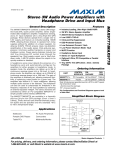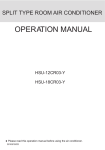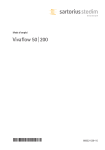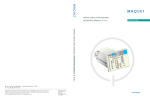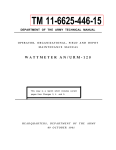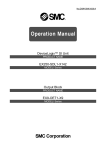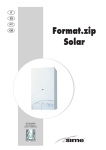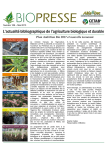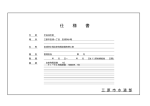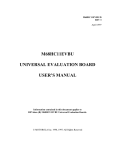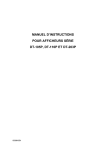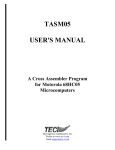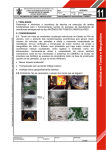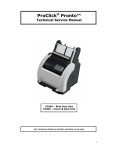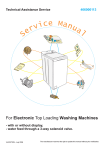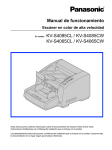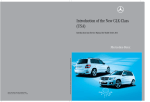Download TASM11 USER`S MANUAL - The Engineers Collaborative, Inc.
Transcript
TASM11 USER'S MANUAL A Cross Assembler Program for Motorola 68HC11 Microcomputers The Engineers Collaborative, Inc. Webite at www.tec-i.com Email [email protected] TASM11 USER'S MANUAL * * * IMPORTANT WARRANTY AND LIABILITY INFORMATION * * * The Engineers Collaborative, Inc. makes no warranties, expressed or implied for this software. No warranty of fitness for a particular purpose is offered. The user is advised to test the software thoroughly before relying on it. The user assumes the entire risk of using the product. The total liability of The Engineers Collaborative, Inc. is limited to the purchase price of the product, and does not cover any lost profits, special, incidental or consequential damages, or any claim against the purchaser by any party. * * * SOFTWARE LICENSE STATEMENT * * * US copyright law and international treaty provisions protect this software. Therefore, you must treat this software just like a book, with the following exception. The Engineers Collaborative, Inc. authorizes you to make archival copies of the software for the sole purpose of backing-up our software and protecting your investment from loss. By saying, just like a book, The Engineers Collaborative, Inc. means that the software cannot be used by two different people in two different places at the same time. * * * OTHER * * * The information contained in this manual has been carefully checked and is believed to be accurate and complete at the time of printing. However, no responsibility is assumed for errors that might appear. The Engineers Collaborative, Inc. reserves the right to make changes to the product and/or the manual at any time without notice. Furthermore, The Engineers Collaborative, Inc. assumes no liability arising out of the use or application of any of its products. No part of this document may be copied or reproduced in any form or by any means without prior written consent of The Engineers Collaborative, Inc. (C) Copyright 1989-2004 The Engineers Collaborative, Inc. Web Site at www.tec-i.com Email [email protected] All Rights Reserved Printed in the U.S.A. The Engineers Collaborative Inc. Page 2 TASM11 USER'S MANUAL TABLE OF CONTENTS 1.0 Introduction ..................................................................................................................... 5 2.0 2.1 2.2 2.3 Getting Started ................................................................................................................. 5 The Distribution Diskette ..................................................................................................... 5 Backing up the distribution diskette...................................................................................... 6 Creating a Working Copy Diskette ....................................................................................... 6 3.0 Running TASM11 ........................................................................................................ 6 3.1 Output Control Switches ................................................................................................. 7 3.2 Examples .......................................................................................................................... 8 4.0 TASM11 Source Files ..................................................................................................... 9 5.0 Expressions ................................................................................................................... 11 6.0 6.1 6.2 6.3 6.4 6.5 6.6 6.7 TASM11 Pseudo-operations ........................................................................................ Storage Definition Pseudo-ops ...................................................................................... ORG and END Pseudo-ops ............................................................................................ Symbolic Constants ......................................................................................................... Include Pseudo-op .......................................................................................................... Listing Control Pseudo-ops ............................................................................................ OPT (option) Pseudo-op .............................................................................................. Null Pseudo-ops ............................................................................................................ 11 11 16 17 17 18 19 20 7.0 7.1 7.2 7.3 Error Messages ............................................................................................................... Fatal Errors .................................................................................................................... Non-Fatal Errors ............................................................................................................. Warning Errors .............................................................................................................. 20 21 22 25 8.0 8.1 8.2 8.3 68HC11 Addressing Modes ............................................................................................ Inherent Addressing ....................................................................................................... Immediate Addressing ..................................................................................................... Direct Addressing .......................................................................................................... 25 26 26 26 The Engineers Collaborative Inc. Page 3 TASM11 USER'S MANUAL Table of Contents (cont.) 8.4 Extended Addressing ...................................................................................................... 26 8.5 Indexed Addressing ............................................................................................................ 27 8.6 Relative Addressing ........................................................................................................ 27 9.0 9.1 9.2 9.3 Output File Format............................................................................................................. 28 Listing File Format ........................................................................................................ 28 Motorola S-Record Object File Format ........................................................................... 28 Intel HEX Object File Format .......................................................................................... 29 Appendix A - Instruction Mnemonics,opcodes and addressing modes ................................................................................................................... 30 1.0 INTRODUCTION The Engineers Collaborative Inc. Page 4 TASM11 USER'S MANUAL TASM11 is a 68HC11 cross assembler program. It is designed to run on the IBM family of personal computers under the PC-DOS disk operating system Version 2.1 or higher. It also runs on true IBM compatible personal computers. TASM11 takes its input from a PC-DOS text file and creates as output an object code file in either Intel HEX or Motorola S-record format and a listing file in PC-DOS text format. When invoking TASM11 a number of option switches may be used to control the output generated. A variety of pseudo-operation codes may be included in the source code text file to control the format of the output generated. This manual is intended as a reference document for the experienced 68HC11 assembly language programmer. It is assumed that the user is familiar with the 68HC11 instruction set and chip architure. Less experienced users should become familiar with the information contained in the following publicationsavailable from Motorola Semiconductor Products Inc. 3501 Ed Bluestein Blvd., Austin, Texas 78721 MOTOROLA SINGLE-CHIP MICROCOMPUTER DATA (DL132R1) MC68HC11A8 PROGRAMMING REFERENCE GUIDE (MC68HC11A8RG/AD) 2.0 GETTING STARTED Before using the TASM11 program for the first time the user should take the time to 1) make one or more copies of the distribution diskette, 2) make one or more bootable working copy diskettes and 3) READ THE MANUAL! 2.1 The Distribution Diskette The Engineers Collaborative, Inc. TASM11 Cross Assembler Program is supplied on a 3 1/2 inch double sided double density floppy diskette. The file supplied on this diskette is as follows: TASM11.EXE This file contains the 68HC11 cross assembler program. 2.2 Backing up the distribution diskette The Engineers Collaborative Inc. Page 5 TASM11 USER'S MANUAL Use the DOS "DISKCOPY" command to make at least one backup copy of thedistribution diskette. When this is done, one of the backup copies should be used to create "working copy" diskettes as described below. At least one backup copy and the original distribution diskette should then be stored in a safe place for use the inevitable day when disaster strikes! 2.3 Creating Working Copy Diskettes Use the DOS "FORMAT" command with the /s option to format the number of working copy diskettes that you wish to create. The /s option copies the files required to make the working copy diskette a "bootable" or "system" diskette. Use the DOS "COPY" command to copy all of the files supplied on the distribution diskette to the working copy diskettes. Use the DOS "COPY" command to copy the DOS file ANSI.SYS to the working copy diskettes. This file must have been supplied with the disk operating system for your computer. Note: This file is not required if only TASM11 is to be used, but is required for all other The Engineers Collaborative, Inc. software development tools. Use the DOS "COPY" command to copy the text editor program that you will be using to create 68HC11 source code files to the working copy diskettes. At this point you have finished creating the working copy diskettes but to use the software tools you must make sure that the extended screen and keyboard device driver(ANSI.SYS) is loaded. The easiest way to do this is to boot the system with the working copy diskette in the boot drive. 3.0 RUNNING TASM11 To invoke TASM11, type at the DOS ready prompt: [d:]TASM11 [d:]fname.asm [option 1] [option 2] . . . [d:] denotes optional drive specifiers where the TASM11 program or the source file is to be found and [option] denotes optional output control switches. The output files will always be directed to the currently logged drive. fname.asm is the source code filename. There is no default source file extension so the extension, if any, must be included when invoking TASM11. Any number of output control options may follow the source file name and these options can be in any order. Options must be separated by one or more spaces. The Engineers Collaborative Inc. Page 6 TASM11 USER'S MANUAL Normally, TASM11 generates two output files, a listing file and an object code file. These files have the same name as the source code file with different file extensions. The listing file has extension '.PRN' and the object code file has extension '.MIK' or optionally '.HEX'. Object code files with extension '.MIK' are in Motorola S record format and object code files with extension '.HEX' are in Intel HEX format. The default format is '.MIK' TASM11 is a two pass assembler, it must read the source file twice to complete the generation of object code. On the first pass through the source file statements TASM11 does only the work required to associate values with the symbols that appear in the source file. The output files are generated on the second pass. If errors are found on the first pass, error messages are displayed on the screen and TASM11 terminates before attempting the second pass. 3.1 OUTPUT CONTROL SWITCHES The output control switches are 3 letter mnemonics that are typed on the command line following the source code filename when invoking TASM11. These switches control the output generated by TASM11 as follows: NLF NO LISTING FILE - NLF can be used to prevent the generation of the listing file. This switch might be used when first assembling a source code file to see if the file assembles without errors. NOF NO OBJECT FILE - NOF can be used to prevent the generation of the object code file. It might be used in the same manner as NLF. NST NO SYMBOL TABLE - NST prevents the generation of the symbol table. The symbol table is an alphabetical listing of all symbols and their associated values. The symbol table is appended to the end of the listing file. LTP LIST TO PRINTER - LTP can be used to send a copy of the listing file to the printer. HEX Changes the object code file format to INTEL HEX. WOE WAIT ON ERROR - WOE is used to prevent error messages from scrolling off the screen before they can be read. When used, The Engineers Collaborative Inc. Page 7 TASM11 USER'S MANUAL assembly is halted after an error message has been sent to the screen until the operator presses any key. SPF SUPPRESS PAGE FORMATTING - This switch is used to suppress normal page formatting. TASM11 normally inserts a form feed character into the listing file after each 64 lines (or after the number of lines specified by the PGLEN pseudo-op) then it inserts 5 lines of page header information into the listing file. See section 5.5. The SPF switch is used to prevent this page formatting. 3.2 EXAMPLES Some examples of invoking TASM11 follow. The examples assume that a source code file named WIDGET.ASM exists. Type at the DOS ready prompt: TASM11 WIDET.ASM or tasm11 widget.asm In this example no output control switches are used therefore a listing file will be created on the currently logged drive named WIDGET.PRN and an object code file will be created in Motorola S record format named WIDGET.MIK. If we had typed at the DOS ready prompt: TASM11 WIDGET.ASM HEX LTP a listing file named WIDGET.PRN and an object code file named WIDGET.HEX in Intel HEX format would have been created and a copy of the listing file would have been sent to the printer. If we had typed: TASM11 WIDGET.ASM NOF NLF WOE no output files would be created and if errors were detected in the source The Engineers Collaborative Inc. Page 8 TASM11 USER'S MANUAL file the program would pause after displaying the error message until the operator pressed any key. 4.0 TASM11 SOURCE FILES Source code files compatible with TASM11 are standard PC-DOS ASCII text files. The only control codes that can be present in the files are carriage return (CR), line feed (LF) and horizontal tab characters. These files may be created by the EDLIN text editor supplied with DOS but it is recommended that a more sophisticated editor such as Personal Editor from IBM, Wordstar used in the non-document mode or the Sidekick notepad editor be used. The reader is encouraged to study the example listing in Appendix A to acquire an understanding of source code syntax and format acceptable to TASM11. Source files consist of a series of statements of one of the following forms where [] denotes optional statement fragments: [*comment] or [;comment] symbol symbol OPCODE OPCODE PSEUDO-OP PSEUDO-OP [arguments] [arguments] [arguments] [arguments] [comment] [comment] [comment] [comment] PCODE is any standard 68HC11 operation code and must not start in the first column of a statement. Opcodes can be either upper or lower case characters or combinations of both. BRCLR and BrClr are considered the same by TASM11. PSEUDO-OP is any TASM11 pseudo-operation and must not start in the first column of a statement. TASM11 pseudo-ops are described later in this document. They can be either upper or lower case characters or combinations of both. Symbols, if present, must start in column 1 of the statement, consist of 1 to 15 ASCII alphanumeric characters and begin with a letter, a period, or an underscore. Capital letters are significant in symbol names. That is the assembler will treat 'Dog', 'dog' and 'doG' as unique symbols. Comments must be preceded by a semicolon (;) or an asteric (*) when they appear on a line by themselves. Comments that appear as the last field of a line do not have to be preceded by a semicolon or asteric but must be preceded by a space or horizontal tab character and can not start with an expression The Engineers Collaborative Inc. Page 9 TASM11 USER'S MANUAL operator character (+ - * /....). The fields of a statement must be delimited by at least one space or a horizontal tab character. The arguments portion of a statement consists of from 1 to 4 symbols, numeric constants, character constants, expressions or combinations depending on the OPCODE or PSEUDO-OP. Constants consist of a sequence of characters optionally preceded by a radix specifier. The default radix is ten. A radix of 16 may be specified by a leading $ or by a trailing H. If a trailing H is used the first digit of the constant must be a decimal digit. As an example the numeric constant 15 may be specified as 15, $F, or as 0FH. Constant examples: One_hundred One_hundred One_hundred One_hundred Two_hundred EQU 100 a decimal constant EQU $64 a hexadecimal constant EQU @144 an octal constant EQU %1100100 a binary constant EQU 0C8H another form of hex constant Character constants are enclosed in single or double quotes (' or "). As an example, the statement: TEXT DB "The quick brown fox." is equivalent to the statement: TEXT DB 'The quick brown fox.' 5.0 EXPRESSIONS Expressions may consist of symbols, constants or the characters * or $ (* or $ denote the current value of the program counter) joined together by one of the operators: +-*/%&|^. The operators are the same as in C: + * add subtract multiply The Engineers Collaborative Inc. Page 10 TASM11 USER'S MANUAL / % & | ^ divide remainder after division bitwise logical and bitwise logical or bitwise logical exclusive or Expressions are evaluated left to right and there is no provision for parenthesized expressions. Arithmetic is carried out in signed two's compliment integer precision (16 bits on the IBM PC). Constants are constructed as follows: ' $ @ % digits followed by an ASCII character followed by hexadecimal constant followed by an octal constant followed by a binary constant decimal constant Refer to the listing in appendix a for examples of correct expression syntax. 6.0 TASM11 PSEUDO-OPERATIONS 6.1 Storage Definition Pseudo-Ops DEFINE BYTES Symbol DB Argument or DB Argument The define bytes pseudo-op is used to initialize memory locations to the value of the argument. It can also be used to associate a symbolic name to the memory location. The argument must be either a numeric constant or a character string constant. Numeric constants must be a value between 0H and 0FFH. Examples: symbol DB DB DB DB DB $FF 0B3H 255 'How now brown cow' "How now brown cow" The Engineers Collaborative Inc. Page 11 TASM11 USER'S MANUAL DEFINE WORD Symbol DW Argument or DW Argument The define word pseudo-op is used to initialize two consecutive memory locations to the value of the argument. It can also be used to associate a symbolic name to the first of 2 memory locations. The argument must be a numeric constant with value between 0H and 0FFFFH. Examples: symbol DW DW DW DW 0 257 0FC49H $FFFF DEFINE STORAGE Symbol DS Argument or DS Argument The define storage pseudo-op is used to reserve the number of consecutive memory locations specified by the argument. It can also be used to associate a symbolic name to the first of these memory locations. The argument must be a numeric constant with value between 0 and 255. The bytes reserved are not initialized. Examples: symbol DS 10 ;reserves 10 bytes of storage DS 10H ;reserves 16 bytes of storage FORM CONSTANT BYTES Symbol FCB Argument or FCB Argument The form constant bytes pseudo-op is used to initialize one or more memory locations to the values specified by the argument. It can also be used to associate a symbolic name to the memory location. The Engineers Collaborative Inc. Page 12 TASM11 USER'S MANUAL The values of the argument must be either numeric constants, character constants or symbol names that have been previously defined. The values of the argument must be separated by commas. Numeric constants must be a value between 0H and 0FFH. Examples: symbol FCB $FF FCB 0B3H, %01110000 FCB 1, 2, 3, 4 FORM DOUBLE BYTES Symbol FDB Argument or FDB Argument The form double bytes pseudo-op is used to initialize two or more consecutive memory locations to the values specified by the argument. It can also be used to associate a symbolic name to the memory location. The values of the argument must be either numeric constants, character constants or symbol names that have been previously defined. The values of the argument must be separated by commas. Numeric constants must be a value between 0H and 0FFFFH. Examples: symbol FDB $FFFF FDB 0B333H, %1110111001110000 FDB 1, 2, 3, 4 RESERVE MEMORY BYTES RMB Argument or Symbol RMB Argument The reserve memory bytes pseudo-op is used to reserve the number of consecutive memory locations specified by the argument. It can also be used to associate a symbolic name to the first of these memory locations. The argument must be a numeric constant with value between 0 and 255. The bytes reserved are not initialized. The Engineers Collaborative Inc. Page 13 TASM11 USER'S MANUAL Examples: symbol RMB 10 ;reserves 10 bytes of storage RMB 10H ;reserves 16 bytes of storage BLOCK STORE ZEROS Symbol BSZ Argument or BSZ Argument The block store zeros pseudo-op is used to reserve the number of consecutive memory locations specified by the argument. It can also be used to associate a symbolic name to the first of these memory locations. The argument must be a numeric constant with value between 0 and 255. The bytes reserved are each initialized to zero. Examples: symbol BSZ 10 ;reserves 10 bytes of storage initialized to zero BSZ 10H ;reserves 16 bytes of storage initialized to zero ZERO MEMORY BYTES Symbol ZMB Argument or ZMB Argument The zero memory bytes pseudo-op is the same as the BSZ pseudo-op described above. It is included in TASM11 for compatibility with other assemblers. FORM CONSTANT CHARACTERS Symbol FCC Argument or FCC Argument The Engineers Collaborative Inc. Page 14 TASM11 USER'S MANUAL The form constant characters pseudo-op is used to initialize one or more consecutive memory locations to the string characters specified by the argument. The characters of the string must be delimited by (') or ("). Examples: Symbol FCC 'Now is the time for all good men. . .' FCC "How now brown cow." FILL Symbol FILL Argument1,Argument2 or FILL Argument1,Argument2 The fill pseudo-op is used to fill the number of consecutive memory locations specified by argument2 with the value specified by argument1. The arguments must be separated by a comma. The value of argument1 must be between 0 and 255. Examples: Symbol FILL $FF, 10 FILL 1,3 fills ten memory locations with 0FFH fills three memory locations with one's. 6.2 ORG and END Pseudo-Ops ORG argument Set program origin. Sets the program counter to the value of the argument. This statement must precede the first code generating statement in a source file. Additional ORG pseudo-ops may be used throughout the source file to create separate program fragments. The argument may be a numeric constant or an expression as shown in the examples below. Examples: ORG 100H ;sets origin to 256 The Engineers Collaborative Inc. Page 15 TASM11 USER'S MANUAL ORG ORG ORG ORG ORG ORG memsize 10 * 2 10 / 2 10 - 2 10 + 2 $+2 *+2 EQU 2 * 1024 ORG memsize - 8 ;sets origin to 20 ;sets origin to 5 ;sets origin to 8 ;sets origin to 12 ;sets origin to current value of pc + 2 ;sets origin to current value of pc + 2 Note that either $ or * may be used to specify current program counter value. ;memsize = 2048 ;sets origin to 2040 END argument The END pseudo-op is an optional statement that can be included as the last statement of the primary source file(INCLUDE files must not have an END statement). If used, the value of the argument becomes the start address specified by the end record of the object code file. The argument must be a numeric or symbolic constant with value between 0H and 0FFFFH. Examples: END 80H start EQU 80H END start 6.3 Symbolic Constants symbol EQU argument The EQU pseudo-op assigns the value of the argument to the symbol name. The argument must be a numeric constant or an expression. Once defined by EQU the symbolic name may be used throughout the source file in place of its value. Once a symbol has been assigned a value by the EQU pseudo-op the same symbol can not be assigned another value elsewhere in the source file. Symbolic constants are constants! The Engineers Collaborative Inc. Page 16 TASM11 USER'S MANUAL Examples: PORTA memsize EQU EQU $1000 2 * 1024 ldx bset ORG #PORTA 0,x $01 memsize - 10 6.4 Include Pseudo-OP This pseudo-op causes the specified file to be processed as if its source code statements were present in the main source file at the location of the INCLUDE pseudo-op. Included files must not contain INCLUDE pseudo-ops. Include files can not be nested! The main source file can contain any number of INCLUDE pseudo-ops. Included files must not contain an END pseudo-op. If the file to be included does not reside on the currently logged drive, the filename must contain the drive specification. Examples: INCLUDE INCLUDE INCLUDE B:MYFILE.ASM EQUATES.ASM A:TIMERISR.ASM 6.5 Listing Control Pseudo-Ops PAGE The PAGE (or optionally just PAG) pseudo-op causes a form feed character to be inserted into the listing output file. This causes the printed listing to skip to the top of the next page. PGLEN argument The PGLEN pseudo-op sets the number of lines that will be printed on each page of the listing to the value specified by the argument. The argument must be a numeric constant. The Engineers Collaborative Inc. Page 17 TASM11 USER'S MANUAL Examples: PGLEN PGLEN 55 66 TITLE SBTTL 'text' 'text' Each page of the listing file contains a heading at the top of the page that is of the following form: blank line The Engineers Collaborative, Inc. 68HC11 Cross Assembler V#.# blank line User specified title User specified subtitle blank line The user specifies the text of the title and subtitle by means of the TITLE and SBTTL pseudo-ops as shown in the following examples. TITLE SBTTL 'Text of users title goes here!' 'The text of the users subtitle goes here!' NOLIST The NOLIST pseudo-op can be used to prevent certain sections of the source file from appearing in the listing file. All lines of the source file after the NOLIST statement in encountered will not appear in the listing file unless a LIST pseudo-op is encountered. LIST The LIST pseudo-op is used to resume the listing of source file lines in the listing file after listing has been stopped with the NOLIST pseudo-op. 6.6 OPT PSEUDO-OP The option (OPT) pseudo-op is included for compatibility with other assemblers. Generally the same functions can be performed with other The Engineers Collaborative Inc. Page 18 TASM11 USER'S MANUAL pseudo-ops. The syntax of the OPT pseudo-op is as follows: OPT option where the option is any of the following: LIST or L same as the LIST pseudo-op NOLIST or NOL same as the NOLIST pseudo-op CYCLES or C does nothing in TASM11 NOCYCLES or NOC does nothing in TASM11 CONTCYCLES or CONTC does nothing in TASM11 Examples: OPT LIST OPT NOLIST 6.7 NULL PSEUDO-OPS Null pseudo-ops are included in TASM11 for compatibility with other assemblers. TASM11 recognizes them so that errors will not be generated but the program performs no functions when thay are encountered. The NULL PSEUDO-OPS are: NAME NAM SPC CYCLES NOCYCLES CONTCYCLES The Engineers Collaborative Inc. Page 19 TASM11 USER'S MANUAL 7.0 ERROR MESSAGES Source files must assemble with no errors before the generated code can be trusted. When no errors are found, TASM11 prints the message "Assembly complete . . . errors = 0, warnings = 0." on the video screen and includes this message at the end of the listing file. When errors are detected a message is displayed on the video screen and an error message is included in the listing file on the line above the line in which the error was detected. Error messages sent to the video screen include a description of the error, the line number of the line in error and the name of the file that contains the line in error. Only one error is detected per line. Before the program ends it prints a message that indicates how many lines contained errors. TASM11 is a two pass assembler. Pass 1 must be completed without errors before pass 2 is started. Errors detected on pass 1 are displayed on the video screen only since the output files are generated on pass 2. If no errors are detected during pass 1 TASM11 prints the message "Starting Pass 2 . . ." on the video screen. 7.1 Fatal Errors Fatal errors are errors serious enough that the assembler can not continue to assemble the source statements. When a fatal error is detected TASM11 prints the error message on the video screen then exits to DOS. Fatal error messages and causes are listed below. "Fatal error - Error - can't open fname" This message is displayed when the main source file typed when invoking TASM11 can not be opened. The file name may have been typed incorrectly or the file may not reside on the currently logged drive or the specified drive. "FATAL ERROR, couldn't open include file fname This message is displayed when an include file can't be opened. The file name may have been typed incorrectly in the main source file or the file may not reside on the currently logged drive or the specified drive. The Engineers Collaborative Inc. Page 20 TASM11 USER'S MANUAL "Fatal error - Error - source file name must follow program name!" This message is displayed when the operator fails to type the name of the source code file after TASM11 when invoking the assembler. "Fatal error - error writing listing file, check disk space!" "Fatal ERROR writing to disk - check disk space. . ." "Fatal error - Can't open output listing file - check disk space" "Fatal error - Can't open output object code file - check disk space" These errors may occur part of the way through an assembly if all of the available disk space on the currently logged drive is used. To correct this error more space will have to be made available on the currently logged drive. "Fatal error - No mem for fwd. refs "Fatal error - No space for fwd. refs These errors may occur if your machine does not have enough available memory to store the required information for the forward references in the source file being assembled. To correct the problem the number of forward references in the source file must be reduced. Currently, TASM11 allocates space for 500 forward references. Fatal error - Error in Mnemonic table If this error appears, the TASM11.EXE program file has been corrupted. A new copy of the program will have to be obtained from a backup copy or from The Engineers Collaborative, Inc.. 7.2 Non-Fatal Errors Non-fatal errors are errors that are detected but not serious enough to cause termination of the assembly. They most certainly are serious enough to prevent the program under development from performing its intended function however. A list of non-fatal errors and probable causes are as follows: These error messages will appear in the listing file on the line above the source statement in which the error was detected. When displayed on the video screen the line number in which the error occurred and the name of file containing the line in error will be printed in front of the error message. The Engineers Collaborative Inc. Page 21 TASM11 USER'S MANUAL "Unrecognized Mnemonic" "Undefined Pseudo Operation" Indicates an invalid opcode field in the source code statement. The opcode or pseudo-op was misspelled or not separated from other fields of the source statement by spaces or tab characters. "Symbol Redefined" An attempt was made to change the definition of an already defined symbol. This can happen if more than one source statement has been given the same label or symbol name. "Illegal Symbol Name" The symbol field contains a symbol that contains characters other than the alphanumeric ASCII characters or the symbol name starts with a character other than the alpha characters or the underscore or the period. "Out of memory space for the symbol table." Your machine does not contain enough available memory space to contain the symbol table. The number of symbols must be reduced or the amount of available memory increased. "Symbol Undefined on Pass 2" The most probable cause of this error is that a symbol name was referred to in the arguments field of a source statement but never appeared in the symbol field of another source statement. As an example, if we had the source statement JMP WATCHDOG and no source statement had WATCHDOG in the symbol field then we would get an undefined symbol error when TASM11 read the JMP statement on pass 2 of the assembly. "Undefined operand on Pass One" The operands for the EQU and ORG statements must be defined on pass 1 and must occur in the source file before they are used. The Engineers Collaborative Inc. Page 22 TASM11 USER'S MANUAL "Branch out of Range" Target addresses for the relative branch instructions must be within -128 to +127 bytes of the first byte of the instruction following the branch instruction. This error indicates that the target address of the branch is outside these limits. "Immediate Addressing Illegal" "Extended Addressing not allowed" "Unknown Addressing Mode" These errors are generated when an illegal or unrecognizeable addressing mode is detected for certain operation codes. "SYNTAX" This is a catch all error message that indicates that the assembler found something that it did not understand but is so confused that it can not give a more specific error message. "Phasing error" Lets hope this error never occurs. It indicates that assumptions made by the assembler on pass 1 were proven invalid on pass 2. If this error occurs check for possible problems related to the size of forward references. Rearrange your code and try again! "Missing Delimiter" "Missing Delimiter Character" These errors occur with the DB or FCC pseudo-ops when the delimiter character is missing from the end of a string constant. "EQU requires lable" An EQU pseudo-op was found that did not have a symbol field. EQU statements must have a symbol with which to equate the value specified by the operand The Engineers Collaborative Inc. Page 23 TASM11 USER'S MANUAL field. "Bad fill" A FILL pseudo-op was found that did not have the proper operands. The FILL spseudo-op requires two operands separated by a comma. "Unrecognized OPT" An OPT pseudo-op was found with an invalid argument or operand. 7.3 WARNING ERRORS Warning errors are generated when the assembler finds unexpected values or statement syntax in the source file. The resulting code generated may or may not be correct. Source files should be corrected so that no warnings errors occur before the generated code is trusted. A list of warning errors and possible causes are as follows: "Value Truncated" An operand was encountered that was larger than 255 when a byte value was expected. The value was truncated to fit in a byte. Indexed Addressing Assumed" Incorrect indexed addressing syntax was found and the indexed addressing mode was assumed. "Continuation too long" The Engineers Collaborative Inc. Page 24 TASM11 USER'S MANUAL To eliminate this warning make sure that each source statement is complete on one line. 8.0 68HC11 ADDRESSING MODES A summary of 68HC11 addressing modes and instruction syntax is provided in this section. The reader is referred to the publications listed in the introduction for additional information. Appendix A contains an actual assembly listing of all the 68HC11 instructions and the addressing modes available for each instruction. This listing should be used to provide more comprehensive examples of proper 68HC11 source code syntax. 8.1 Inherent Addressing Inherent addressing instructions contain the operand information implicitly. These are one byte instructions such as: ROLA ASLA ;Rotate the A register left thru carry ;Arithmetic shift left the A register 8.2 Immediate Addressing In immediate addressing the operand data is contained in the byte(s) following the opcode byte. Immediate addressing is designated by a leading "#". LDA #7 LDX #large ;load the A register with the number 7. ;load the X register with the value of the symbol ;large 8.3 Direct Addressing In direct addressing the address of the operand is contained in the byte following the instruction opcode. Since the address in contained in one byte, direct addressing can only be used to access memory locations in the first page of memory (addresses 0 - 255). The operand field must contain a numeric The Engineers Collaborative Inc. Page 25 TASM11 USER'S MANUAL or symbolic constant. LDA 0 LDB small ;load the A register with the contents of ;memory location 0 ;load the B register with the contents of ;the memory location specified by small. 8.4 Extended Addressing In extended addressing the address of the operand is contained in the two bytes following the instruction opcode. Extended addressing can be used to access any memory location. The operand field must contain a numeric or symbolic constant. LDA 256 LDX large ;load the A register with the contents of ;memory location 256 ;load the X register with the contents of ;the memory location specified by large. 8.5 Indexed Addressing In the indexed addressing mode, one of the index registers(x or y) is used in calculating the effective address. In this case the effective address is variable and depends on two factors. 1) the current contents of the index register(x or y) being used and 2) the the 8 bit unsigned offset contained in the instruction. SMALL EQU 20 LDX LDA #SMALL 0,X LDA 7,X ;load the A reg ;with the contents of address 20 ;load the A reg ;with the contents of address 27 8.6 Relative Addressing Relative addressing is used by the branch instructions and by the bit test and branch instructions BRCLR and BRSET. In relative addressing, the last byte of the instruction is added to the program counter to obtain the address of the next instruction if the branch is taken. The target address of the branch must be within -128 to +127 bytes of the program counter value following the branch instruction. TASM11 calculates the The Engineers Collaborative Inc. Page 26 TASM11 USER'S MANUAL value of the byte to added to the pc value and generates a "branch out of range" error message if these limits are exceeded. BCS timer ;branch to the inst labeled "timer" if the ;carry flag is set ldx #$1000 ;load x with address of port a brclr 0,x $81 timer ;branch to the inst labeled "timer" if ;bits 7 and 1 of port a are zero. 9.0 OUTPUT FILE FORMAT 9.1 Listing file format Each line of the listing file generated by TASM11 can be a maximum of 132 characters long. The text from each line of the source code file is copied to the corresponding line of the listing file starting at column 16. To create neat appearing printed listing files the user must be aware that each listing file line will be 16 columns longer than the source file lines. If listing files will be printed with 80 column lines then the text of the source file lines should occupy 64 columns or less. If listing files will be printed with 132 column lines then the text of the source file lines should occupy 116 columns or less. It is up to the user to set up his printer for the most appropriate line length. Columns 2 - 5 of a listing file line contain a 4 character hexadecimal number that corresponds to the current value of the program counter. Columns 7 - 14 contain the hexadecimal representation of the code generated by TASM11. Each page of the listing file contains a 6 line heading as explained in the description of the TITLE and SBTTL pseudo-ops. At the end of the listing file is the alphabetical listing of all symbols and their associated values in hexadecimal representation. The Engineers Collaborative Inc. Page 27 TASM11 USER'S MANUAL 9.2 Motorola S-record Object File Format Each line of this file has the following format: Bytes 1 & 2"S1 3&4 The number of data bytes in this record + 3. 5&6 Load Address - high byte 7&8 Load Address - low byte 9..X Data bytes, 2 characters each X+1 & X+2 checksum X+3 & X+4 carriage return and linefeed The last record in the file is the same as above except that it starts with "S9 and the load address field contains the program starting address when specified by an END pseudo-op in the source file. This field contains zero otherwise. The checksum is the ones-compliment of the 8 bit sum without carry of the byte count, the load address and the data bytes. 9.3 Intel HEX Object File Format Each line of this file has the following format: Bytes 1 Colon (:) 2&3 Number of data bytes in this record 4 & 5 Load Address - high byte 6&7 Load Address - low byte 8&9 Unused - "00" 10 - X Data bytes - 2 characters each X+1 & X+2 checksum X+3 & x+4 carriage return and linefeed The last line of the file is similar to that described above except the number of data bytes is 0 and the load address is the program starting address if specified by an END pseudo-op in the source file. This field is zero otherwise. The checksum is the twos compliment of the 8 bit sum without carry of all the data bytes, the load address and the byte count. The Engineers Collaborative Inc. Page 28 TASM11 USER'S MANUAL The Engineers Collaborative, Inc. 68HC11 Cross Assembler V1.0 APPENDIX A - TASM11 REFERENCE MANUAL TASM11 SOURCE FILE SYNTAX, OPCODES & ADDRESSING MODE EXAMPLES FFFF 0000 E000 B600 FFC0 ;****************************************************************************** ;** Test File - Fname = TEST11.ASM ** ;** 12/17/87 ** ;****************************************************************************** ; This is a comment line! * This is another form of comment line! ; The following show the syntax of pseudo-ops whose source lines do not show ; up in the listing file. Use as shown without comment char to start the line. ; ; INCLUDE A:MYFILE.ASM ;include MYFILE.ASM ; TITLE'Title text' ;specify the page header title ; SBTTL'Subtitle text' ;specify the page header subtitle ; PGLEN64 ;print 64 lines per page ; NOLIST ;turn listing off ; LIST ;turn listing on ; OPT NOLIST ;another way to turn listing off ; PAGE ;force a page break ; ;Equate examples memory_size EQU 64 * 1024 - 1 ;EXPRESSION EXAMPLE ram_memory equ 0 ;start of ram memory rom_memory equ $e000 ;start of rom memory eeprom_memory equ $b600 ;start of eeprom memory irq_vectors equ $ffc0 ; 1122 0003 00C3 1000 1000 1001 1002 1003 1004 1005 1006 1007 1008 1009 100A 100B WORD BYTE MASK REGISTERS PORTA RESERVED PIOC PORTC PORTB PORTCL RESERVED2 DDRC PORTD DDRD PORTE CFORC EQU EQU EQU EQU EQU EQU EQU EQU EQU EQU EQU EQU EQU EQU EQU EQU 1122H 3 $c3 $1000 REGISTERS REGISTERS+1 REGISTERS+2 REGISTERS+3 REGISTERS+4 REGISTERS+5 REGISTERS+6 REGISTERS+7 REGISTERS+8 REGISTERS+9 REGISTERS+10 REGISTERS+11 ;16 BIT CONSTANT ; 8 BIT CONSTANT ; The Engineers Collaborative Inc. Page 29 TASM11 USER'S MANUAL 100C 100D 100E 100F 1010 1011 1012 1013 1014 1015 1016 1017 1018 1019 101A 101B 101C OC1M OC1D TCNT TCNT1 TIC1 TIC11 TIC2 TIC22 TIC3 TIC33 TOC1 TOC11 TOC2 TOC22 TOC3 TOC33 TOC4 EQU EQU EQU EQU EQU EQU EQU EQU EQU EQU EQU EQU EQU EQU EQU EQU EQU REGISTERS+12 REGISTERS+13 REGISTERS+14 REGISTERS+15 REGISTERS+16 REGISTERS+17 REGISTERS+18 REGISTERS+19 REGISTERS+20 REGISTERS+21 REGISTERS+22 REGISTERS+23 REGISTERS+24 REGISTERS+25 REGISTERS+26 REGISTERS+27 REGISTERS+28 The Engineers Collaborative Inc. Page 30 TASM11 USER'S MANUAL The Engineers Collaborative, Inc. 68HC11 Cross Assembler V1.0 APPENDIX A - TASM11 REFERENCE MANUAL TASM11 SOURCE FILE SYNTAX, OPCODES & ADDRESSING MODE EXAMPLES 101D 101E 101F 1020 1021 1022 1023 1024 1025 1026 1027 1028 1029 102A 102B 102C 102D 102E 102F 1030 1031 1032 1033 1034 1035 1036 1037 1038 1039 103A 103B 103C 103D 103E 103F TOC44 TOC5 TOC55 TCTL1 TCTL2 TMSK1 TFLG1 TMSK2 TFLG2 PACTL PACNT SPCR SPSR SPDR BAUD SCCR1 SCCR2 SCSR SCDR ADCTL ADR1 ADR2 ADR3 ADR4 RESERVED3 RESERVED4 RESERVED5 RESERVED6 OPTION COPRST PPROG HPRIO INIT TEST1 CONFIG EQU EQU EQU EQU EQU EQU EQU EQU EQU EQU EQU EQU EQU EQU EQU EQU EQU EQU EQU EQU EQU EQU EQU EQU EQU EQU EQU EQU EQU EQU EQU EQU EQU EQU EQU REGISTERS+29 REGISTERS+30 REGISTERS+31 REGISTERS+32 REGISTERS+33 REGISTERS+34 REGISTERS+35 REGISTERS+36 REGISTERS+37 REGISTERS+38 REGISTERS+39 REGISTERS+40 REGISTERS+41 REGISTERS+42 REGISTERS+43 REGISTERS+44 REGISTERS+45 REGISTERS+46 REGISTERS+47 REGISTERS+48 REGISTERS+49 REGISTERS+50 REGISTERS+51 REGISTERS+52 REGISTERS+53 REGISTERS+54 REGISTERS+55 REGISTERS+56 REGISTERS+57 REGISTERS+58 REGISTERS+59 REGISTERS+60 REGISTERS+61 REGISTERS+62 REGISTERS+63 The Engineers Collaborative Inc. Page 31 TASM11 USER'S MANUAL The Engineers Collaborative, Inc. 68HC11 Cross Assembler V1.0 APPENDIX A - TASM11 REFERENCE MANUAL TASM11 SOURCE FILE SYNTAX, OPCODES & ADDRESSING MODE EXAMPLES 0001 0001 0001 0001 0006 0007 000A 0002 0080 0005 0007 0006 ONE ONE_1 One One_1 Six SEVEN TEN TWO _128 FIVE SEVEN_1 Complex ; E000 E000 E001 E003 E005 E00F E013 E01B E025 E02D E035 00 0000 00010203 00000001 00020003 48656C6C 6FE020 48656C6C 6F 00000000 00000000 00000000 00000000 FFFFFFFF FFFFFFFF FFFF ; E049 E053 E053 4E6F7720 69732074 68652074 696D6520 666F7220 616C6C20 676F6F64 206D656E 202E202E 202E EQU EQU EQU EQU EQU EQU EQU EQU EQU EQU EQU equ ;expression examples 3-2 this is a comment 3 - 2 another comment 1 + 0 still another comment $10 - 15 still another comment 3*2 multiply Six+1 add 20/2 divide 8% 3 remainder after division $FF & $80 bitwise AND 4 |1 bitwise OR 5 ^ 2 bitwise XOR ONE+ONE_1*Six/TWO =6 (expressions are evaluated left to right) ORG rom_memory DB DW DS RMB FCB FDB 0 0 2 10 0,1,2,3 0,1,2,3 ORIGINATE AT ADDRESS 0 ;EXAMPLES OF STORAGE DEFINITION PSEUDO-OPS define byte example define word example define storage example, reserves 2 bytes reserve 10 memory bytes form constant bytes form double bytes FCC DB 'Hello' 'Hello' form constant characters another way to do it! ZMB 8 zero 8 memory bytes BSZ 8 another way to do it! FILL 0FFH, 10 fill ten bytes with 0ffH ORG $ + 10 ;ORG WITH EXPRESSION ORG * + 10 another way to do it! MESSAGEDB'Now is the time for all good men . . .' a long message The Engineers Collaborative Inc. Page 32 TASM11 USER'S MANUAL The Engineers Collaborative, Inc. 68HC11 Cross Assembler V1.0 APPENDIX A - TASM11 REFERENCE MANUAL TASM11 SOURCE FILE SYNTAX, OPCODES & ADDRESSING MODE EXAMPLES E079 1B E07A 3A E07B 183A ;****************************************************************************** ;**THE FOLLOWING IS AN ASSEMBLY OF ALL 68HC11 OPCODES AND ADDRESSING MODES ** ;****************************************************************************** ; START ABA ;ADD ACCUMULATORS ABX ;ADD B TO X ABY ;ADD B TO Y ;ADD WITH CARRY TO A ADCA #BYTE ;IMMEDIATE ADCA BYTE ;DIRECT ADCA WORD ;EXTENDED ADCA 0,X ;INDEXED BY X ADCA 0,Y ;INDEXED BY Y ADCA BYTE,X ;INDEXED BY X ADCA BYTE,Y ;INDEXED BY Y E07D E07F E081 E084 E086 E089 E08B 8903 9903 B91122 A900 18A900 A903 18A903 E08E E090 E092 E095 E097 E09A E09C C903 D903 F91122 E900 18E900 E903 18E903 ADCB ADCB ADCB ADCB ADCB ADCB ADCB #BYTE BYTE WORD 0,X 0,Y BYTE,X BYTE,Y ;ADD WITH CARRY TO B ;IMMEDIATE ;DIRECT ;EXTENDED ;INDEXED BY X ;INDEXED BY Y ;INDEXED BY X ;INDEXED BY Y 8B03 9B03 BB1122 AB00 18AB00 AB03 18AB03 ADDA ADDA ADDA ADDA ADDA ADDA ADDA #BYTE BYTE WORD 0,X 0,Y BYTE,X BYTE,Y ;ADD MEMORY ;IMMEDIATE ;DIRECT ;EXTENDED ;INDEXED BY ;INDEXED BY ;INDEXED BY ;INDEXED BY TO A E09F E0A1 E0A3 E0A6 E0A8 E0AB E0AD CB03 DB03 FB1122 EB00 18EB00 EB03 18EB03 ADDB ADDB ADDB ADDB ADDB ADDB ADDB #BYTE BYTE WORD 0,X 0,Y BYTE,X BYTE,Y ;ADD MEMORY ;IMMEDIATE ;DIRECT ;EXTENDED ;INDEXED BY ;INDEXED BY ;INDEXED BY ;INDEXED BY TO B E0B0 E0B2 E0B4 E0B7 E0B9 E0BC E0BE C31122 D303 F31122 E300 18E300 E303 18E303 ADDD ADDD ADDD ADDD ADDD ADDD ADDD #WORD BYTE WORD 0,X 0,Y BYTE,X BYTE,Y ;ADD 16 BIT ;IMMEDIATE ;DIRECT ;EXTENDED ;INDEXED BY ;INDEXED BY ;INDEXED BY ;INDEXED BY TO D E0C1 E0C4 E0C6 E0C9 E0CB E0CE E0D0 The Engineers Collaborative Inc. X Y X Y X Y X Y X Y X Y Page 33 TASM11 USER'S MANUAL The Engineers Collaborative, Inc. 68HC11 Cross Assembler V1.0 APPENDIX A - TASM11 REFERENCE MANUAL TASM11 SOURCE FILE SYNTAX, OPCODES & ADDRESSING MODE EXAMPLES E0D3 E0D5 E0D7 E0DA E0DC E0DF E0E1 8403 9403 B41122 A400 18A400 A403 18A403 ANDA ANDA ANDA ANDA ANDA ANDA ANDA #BYTE BYTE WORD 0,X 0,Y BYTE,X BYTE,Y ;AND A WITH ;IMMEDIATE ;DIRECT ;EXTENDED ;INDEXED BY ;INDEXED BY ;INDEXED BY ;INDEXED BY E0E4 E0E6 E0E8 E0EB E0ED E0F0 E0F2 C403 D403 F41122 E400 18E400 E403 18E403 ANDB ANDB ANDB ANDB ANDB ANDB ANDB #BYTE BYTE WORD 0,X 0,Y BYTE,X BYTE,Y ;AND B WITH ;IMMEDIATE ;DIRECT ;EXTENDED ;INDEXED BY ;INDEXED BY ;INDEXED BY ;INDEXED BY 48 58 05 781122 6800 186800 6803 186803 ASLA ASLB ASLD ASL ASL ASL ASL ASL WORD 0,X 0,Y BYTE,X BYTE,Y ;ARITHMETIC ;A INHERENT ;B INHERENT ;D INHERENT ;EXTENDED ;INDEXED BY ;INDEXED BY ;INDEXED BY ;INDEXED BY SHIFT LEFT E0F5 E0F6 E0F7 E0F8 E0FB E0FD E100 E102 47 57 771122 6700 186700 6703 186703 ASRA ASRB ASR ASR ASR ASR ASR WORD 0,X 0,Y BYTE,X BYTE,Y ;ARITHMETIC ;A INHERENT ;B INHERENT ;EXTENDED ;INDEXED BY ;INDEXED BY ;INDEXED BY ;INDEXED BY SHIFT RIGHT E105 E106 E107 E10A E10C E10F E111 E114 24FE BCC $ ;BRANCH IF CARRY CLEAR E116 E119 E11C E120 E123 1503C3 1D00C3 181D00C3 1D03C3 181D03C3 BCLR BCLR BCLR BCLR BCLR BYTE MASK 0,X MASK 0,Y MASK BYTE,X MASK BYTE,Y MASK ;CLEAR BIT(S) ;DIRECT ;INDEXED BY X ;INDEXED BY Y ;INDEXED BY X ;INDEXED BY Y E127 E129 E12B E12D E12F E131 25FE 27FE 2CFE 2EFE 22FE 24FE BCS BEQ BGE BGT BHI BHS $ $ $ $ $ $ ;BRANCH ;BRANCH ;BRANCH ;BRANCH ;BRANCH ;BRANCH IF IF IF IF IF IF MEMORY X Y X Y MEMORY X Y X Y X Y X Y X Y X Y CARRY SET ZERO >= ZERO > ZERO HIGHER HIGHER OR SAME The Engineers Collaborative Inc. Page 34 TASM11 USER'S MANUAL The Engineers Collaborative, Inc. 68HC11 Cross Assembler V1.0 APPENDIX A - TASM11 REFERENCE MANUAL TASM11 SOURCE FILE SYNTAX, OPCODES & ADDRESSING MODE EXAMPLES E133 E135 E137 E13A E13C E13F E141 8503 9503 B51122 A500 18A500 A503 18A503 BITA BITA BITA BITA BITA BITA BITA #BYTE BYTE WORD 0,X 0,Y BYTE,X BYTE,Y ;BIT(S) TEST A WITH MEMORY ;IMMEDIATE ;DIRECT ;EXTENDED ;INDEXED BY X ;INDEXED BY Y ;INDEXED BY X ;INDEXED BY Y E144 E146 E148 E14B E14D E150 E152 C503 D503 F51122 E500 18E500 E503 18E503 BITB BITB BITB BITB BITB BITB BITB #BYTE BYTE WORD 0,X 0,Y BYTE,X BYTE,Y ;BIT(S) TEST B WITH MEMORY ;IMMEDIATE ;DIRECT ;EXTENDED ;INDEXED BY X ;INDEXED BY Y ;INDEXED BY X ;INDEXED BY Y E155 E157 E159 E15B E15D E15F E161 E163 2FFE 25FE 23FE 2DFE 2BFE 26FE 2AFE 20FE BLE BLO BLS BLT BMI BNE BPL BRA $ $ $ $ $ $ $ $ ;BRANCH ;BRANCH ;BRANCH ;BRANCH ;BRANCH ;BRANCH ;BRANCH ;BRANCH E165 1303C3FC E169 1F00C3FC E16D 181F00C3 FB E172 1F03C3FC E176 181F03C3 FB BRCLR BRCLR BRCLR BYTE MASK $ 0,X MASK $ 0,Y MASK $ ;BRANCH IF BIT(S) CLEAR ;DIRECT ;INDEXED BY X ;INDEXED BY Y BRCLR BRCLR BYTE,X MASK $ BYTE,Y MASK $ ;INDEXED BY X ;INDEXED BY Y E17B 21FE BRN $ ;BRANCH NEVER E17D 1203C3FC E181 1E00C3FC E185 181E00C3 FB E18A 1E03C3FC E18E 181E03C3 FB BRSET BRSET BRSET BYTE MASK $ 0,X MASK $ 0,Y MASK $ ;BRANCH IF BIT(S) SET ;DIRECT ;INDEXED BY X ;INDEXED BY Y BRSET BRSET BYTE,X MASK $ BYTE,Y MASK $ ;INDEXED BY X ;INDEXED BY Y E193 E196 E199 E19D E1A0 BSET BSET BSET BSET BSET BYTE MASK 0,X MASK 0,Y MASK BYTE,X MASK BYTE,Y MASK ;SET BIT(S) ;DIRECT ;INDEXED BY ;INDEXED BY ;INDEXED BY ;INDEXED BY BSR BVC BVS $ $ $ ;BRANCH TO SUBROUTINE ;BRANCH IF OVERFLOW CLEAR ;BRANCH IF OVERFLOW SET 1403C3 1C00C3 181C00C3 1C03C3 181C03C3 E1A4 8DFE E1A6 28FE E1A8 29FE IF <= ZERO IF LOWER IF LOWER OR SAME IF < ZERO IF MINUS IF != ZERO IF PLUS ALWAYS X Y X Y The Engineers Collaborative Inc. Page 35 TASM11 USER'S MANUAL The Engineers Collaborative, Inc. 68HC11 Cross Assembler V1.0 APPENDIX A - TASM11 REFERENCE MANUAL TASM11 SOURCE FILE SYNTAX, OPCODES & ADDRESSING MODE EXAMPLES E1AA 11 E1AB 0C E1AC 0E CBA CLC CLI E1AD E1B0 E1B2 E1B5 E1B7 CLR CLR CLR CLR CLR 7F1122 6F00 186F00 6F03 186F03 ;COMPARE A TO B ;CLEAR CARRY BIT ;CLEAR INTERRUPT MASK WORD 0,X 0,Y BYTE,X BYTE,Y ;CLEAR MEMORY BYTE ;EXTENDED ;INDEXED BY X ;INDEXED BY Y ;INDEXED BY X ;INDEXED BY Y E1BA 4F E1BB 5F CLRA CLRB ;CLEAR A ;CLEAR B E1BC 0A CLV ;CLEAR OVERFLOW FLAG E1BD E1BF E1C1 E1C4 E1C6 E1C9 E1CB 8103 9103 B11122 A100 18A100 A103 18A103 CMPA CMPA CMPA CMPA CMPA CMPA CMPA #BYTE BYTE WORD 0,X 0,Y BYTE,X BYTE,Y ;COMPARE A TO MEMORY ;IMMEDIATE ;DIRECT ;EXTENDED ;INDEXED BY X ;INDEXED BY Y ;INDEXED BY X ;INDEXED BY Y E1CE E1D0 E1D2 E1D5 E1D7 E1DA E1DC C103 D103 F11122 E100 18E100 E103 18E103 CMPB CMPB CMPB CMPB CMPB CMPB CMPB #BYTE BYTE WORD 0,X 0,Y BYTE,X BYTE,Y ;COMPARE B TO MEMORY ;IMMEDIATE ;DIRECT ;EXTENDED ;INDEXED BY X ;INDEXED BY Y ;INDEXED BY X ;INDEXED BY Y E1DF E1E0 E1E1 E1E4 E1E6 E1E9 E1EB 43 53 731122 6300 186300 6303 186303 COMA COMB COM COM COM COM COM WORD 0,X 0,Y BYTE,X BYTE,Y ;COMPLIMENT ;A ;B ;EXTENDED ;INDEXED BY ;INDEXED BY ;INDEXED BY ;INDEXED BY E1EE E1F2 E1F5 E1F9 E1FC E1FF E202 1A831122 1A9303 1AB31122 1AA300 CDA300 1AA303 CDA303 CPD CPD CPD CPD CPD CPD CPD #WORD BYTE WORD 0,X 0,Y BYTE,X BYTE,Y ;COMPARE D TO MEMORY ;IMMEDIATE ;DIRECT ;EXTENDED ;INDEXED BY X ;INDEXED BY Y ;INDEXED BY X ;INDEXED BY Y X Y X Y The Engineers Collaborative Inc. Page 36 TASM11 USER'S MANUAL The Engineers Collaborative, Inc. 68HC11 Cross Assembler V1.0 APPENDIX A - TASM11 REFERENCE MANUAL TASM11 SOURCE FILE SYNTAX, OPCODES & ADDRESSING MODE EXAMPLES E205 E208 E20A E20D E20F E212 E214 8C1122 9C03 BC1122 AC00 CDAC00 AC03 CDAC03 CPX CPX CPX CPX CPX CPX CPX #WORD BYTE WORD 0,X 0,Y BYTE,X BYTE,Y ;COMPARE X TO MEMORY ;IMMEDIATE ;DIRECT ;EXTENDED ;INDEXED BY X ;INDEXED BY Y ;INDEXED BY X ;INDEXED BY Y E217 E21B E21E E222 E225 E228 E22B 188C1122 189C03 18BC1122 1AAC00 18AC00 1AAC03 18AC03 CPY CPY CPY CPY CPY CPY CPY #WORD BYTE WORD 0,X 0,Y BYTE,X BYTE,Y ;COMPARE Y TO MEMORY ;IMMEDIATE ;DIRECT ;EXTENDED ;INDEXED BY X ;INDEXED BY Y ;INDEXED BY X ;INDEXED BY Y E22E 19 DAA ;DECIMAL ADJUST A E22F E230 E231 E234 E236 E239 E23B DECA DECB DEC DEC DEC DEC DEC ;DECREMENT ;A ;B ;EXTENDED ;INDEXED BY ;INDEXED BY ;INDEXED BY ;INDEXED BY 4A 5A 7A1122 6A00 186A00 6A03 186A03 WORD 0,X 0,Y BYTE,X BYTE,Y E23E 34 E23F 09 E240 1809 DES DEX DEY E242 E244 E246 E249 E24B E24E E250 8803 9803 B81122 A800 18A800 A803 18A803 EORA EORA EORA EORA EORA EORA EORA #BYTE BYTE WORD 0,X 0,Y BYTE,X BYTE,Y ;XOR A WITH ;IMMEDIATE ;DIRECT ;EXTENDED ;INDEXED BY ;INDEXED BY ;INDEXED BY ;INDEXED BY E253 E255 E257 E25A E25C E25F E261 C803 D803 F81122 E800 18E800 E803 18E803 EORB EORB EORB EORB EORB EORB EORB #BYTE BYTE WORD 0,X 0,Y BYTE,X BYTE,Y ;XOR B WITH ;IMMEDIATE ;DIRECT ;EXTENDED ;INDEXED BY ;INDEXED BY ;INDEXED BY ;INDEXED BY E264 03 E265 02 X Y X Y ;DECREMENT STACK POINTER ;DECREMENT X ;DECREMENT Y FDIV IDIV MEMORY X Y X Y MEMORY X Y X Y ;FRACTIONAL DIVIDE 16 BY 16 ;INTEGER DIVIDE 16 BY 16 The Engineers Collaborative Inc. Page 37 TASM11 USER'S MANUAL The Engineers Collaborative, Inc. 68HC11 Cross Assembler V1.0 APPENDIX A - TASM11 REFERENCE MANUAL TASM11 SOURCE FILE SYNTAX, OPCODES & ADDRESSING MODE EXAMPLES E266 E267 E268 E26B E26D E270 E272 4C 5C 7C1122 6C00 186C00 6C03 186C03 INCA INCB INC INC INC INC INC WORD 0,X 0,Y BYTE,X BYTE,Y ;INCREMENT ;A ;B ;EXTENDED ;INDEXED BY ;INDEXED BY ;INDEXED BY ;INDEXED BY X Y X Y E275 31 E276 08 E277 1808 INS INX INY ;INCREMENT STACK POINTER ;INCREMENT X ;INCREMENT Y E279 E27C E27E E281 E283 7E1122 6E00 186E00 6E03 186E03 JMP JMP JMP JMP JMP WORD 0,X 0,Y BYTE,X BYTE,Y ;JUMP ;EXTENDED ;INDEXED BY ;INDEXED BY ;INDEXED BY ;INDEXED BY E286 E288 E28B E28D E290 E292 9D03 BD1122 AD00 18AD00 AD03 18AD03 JSR JSR JSR JSR JSR JSR BYTE WORD 0,X 0,Y BYTE,X BYTE,Y ;JUMP TO SUBROUTINE ;DIRECT ;EXTENDED ;INDEXED BY X ;INDEXED BY Y ;INDEXED BY X ;INDEXED BY Y E295 E297 E299 E29C E29E E2A1 E2A3 8603 9603 B61122 A600 18A600 A603 18A603 LDAA LDAA LDAA LDAA LDAA LDAA LDAA #BYTE BYTE WORD 0,X 0,Y BYTE,X BYTE,Y ;LOAD ACCUM ;IMMEDIATE ;DIRECT ;EXTENDED ;INDEXED BY ;INDEXED BY ;INDEXED BY ;INDEXED BY C603 D603 F61122 E600 18E600 E603 18E603 LDAB LDAB LDAB LDAB LDAB LDAB LDAB #BYTE BYTE WORD 0,X 0,Y BYTE,X BYTE,Y ;LOAD ACCUM ;IMMEDIATE ;DIRECT ;EXTENDED ;INDEXED BY ;INDEXED BY ;INDEXED BY ;INDEXED BY B E2A6 E2A8 E2AA E2AD E2AF E2B2 E2B4 CC1122 DC03 FC1122 EC00 18EC00 EC03 18EC03 LDD LDD LDD LDD LDD LDD LDD #WORD BYTE WORD 0,X 0,Y BYTE,X BYTE,Y ;LOAD ACCUM ;IMMEDIATE ;DIRECT ;EXTENDED ;INDEXED BY ;INDEXED BY ;INDEXED BY ;INDEXED BY D E2B7 E2BA E2BC E2BF E2C1 E2C4 E2C6 X Y X Y A X Y X Y X Y X Y X Y X Y The Engineers Collaborative Inc. Page 38 TASM11 USER'S MANUAL The Engineers Collaborative, Inc. 68HC11 Cross Assembler V1.0 APPENDIX A - TASM11 REFERENCE MANUAL TASM11 SOURCE FILE SYNTAX, OPCODES & ADDRESSING MODE EXAMPLES E2C9 E2CC E2CE E2D1 E2D3 E2D6 E2D8 8E1122 9E03 BE1122 AE00 18AE00 AE03 18AE03 LDS LDS LDS LDS LDS LDS LDS #WORD BYTE WORD 0,X 0,Y BYTE,X BYTE,Y ;LOAD STACK ;IMMEDIATE ;DIRECT ;EXTENDED ;INDEXED BY ;INDEXED BY ;INDEXED BY ;INDEXED BY POINTER X Y X Y E2DB E2DE E2E0 E2E3 E2E5 E2E8 E2EA CE1122 DE03 FE1122 EE00 CDEE00 EE03 CDEE03 LDX LDX LDX LDX LDX LDX LDX #WORD BYTE WORD 0,X 0,Y BYTE,X BYTE,Y ;LOAD X ;IMMEDIATE ;DIRECT ;EXTENDED ;INDEXED BY ;INDEXED BY ;INDEXED BY ;INDEXED BY X Y X Y E2ED E2F1 E2F4 E2F8 E2FB E2FE E301 18CE1122 18DE03 18FE1122 1AEE00 18EE00 1AEE03 18EE03 LDY LDY LDY LDY LDY LDY LDY #WORD BYTE WORD 0,X 0,Y BYTE,X BYTE,Y ;LOAD Y ;IMMEDIATE ;DIRECT ;EXTENDED ;INDEXED BY ;INDEXED BY ;INDEXED BY ;INDEXED BY X Y X Y E304 E305 E306 E307 E30A E30C E30F E311 48 58 05 781122 6800 186800 6803 186803 LSLA LSLB LSLD LSL LSL LSL LSL LSL WORD 0,X 0,Y BYTE,X BYTE,Y ;LOGICAL SHIFT LEFT ;A ;B ;D ;EXTENDED ;INDEXED BY X ;INDEXED BY Y ;INDEXED BY X ;INDEXED BY Y E314 E315 E316 E317 E31A E31C E31F E321 44 54 04 741122 6400 186400 6403 186403 LSRA LSRB LSRD LSR LSR LSR LSR LSR WORD 0,X 0,Y BYTE,X BYTE,Y ;LOGICAL SHIFT RIGHT ;A ;B ;D ;EXTENDED ;INDEXED BY X ;INDEXED BY Y ;INDEXED BY X ;INDEXED BY Y E324 3D MUL ;MULTIPLY 8 X 8 E325 E326 E327 E32A E32C E32F E331 NEGA NEGB NEG NEG NEG NEG NEG ;NEGATE(2'S ;A ;B ;EXTENDED ;INDEXED BY ;INDEXED BY ;INDEXED BY ;INDEXED BY 40 50 701122 6000 186000 6003 186003 WORD 0,X 0,Y BYTE,X BYTE,Y COMPLIMENT) X Y X Y The Engineers Collaborative Inc. Page 39 TASM11 USER'S MANUAL The Engineers Collaborative, Inc. 68HC11 Cross Assembler V1.0 APPENDIX A - TASM11 REFERENCE MANUAL TASM11 SOURCE FILE SYNTAX, OPCODES & ADDRESSING MODE EXAMPLES E334 01 NOP ;NO OPERATION E335 E337 E339 E33C E33E E341 E343 8A03 9A03 BA1122 AA00 18AA00 AA03 18AA03 ORAA ORAA ORAA ORAA ORAA ORAA ORAA #BYTE BYTE WORD 0,X 0,Y BYTE,X BYTE,Y ;OR ACCUM A ;IMMEDIATE ;DIRECT ;EXTENDED ;INDEXED BY ;INDEXED BY ;INDEXED BY ;INDEXED BY X Y X Y E346 E348 E34A E34D E34F E352 E354 CA03 DA03 FA1122 EA00 18EA00 EA03 18EA03 ORAB ORAB ORAB ORAB ORAB ORAB ORAB #BYTE BYTE WORD 0,X 0,Y BYTE,X BYTE,Y ;OR ACCUM B ;IMMEDIATE ;DIRECT ;EXTENDED ;INDEXED BY ;INDEXED BY ;INDEXED BY ;INDEXED BY X Y X Y E357 E358 E359 E35A E35C E35D E35E E35F 36 37 3C 183C 32 33 38 1838 PSHA PSHB PSHX PSHY PULA PULB PULX PULY ;PUSH ;PUSH ;PUSH ;PUSH ;PULL ;PULL ;PULL ;PULL E361 E362 E363 E366 E368 E36B E36D 49 59 791122 6900 186900 6903 186903 ROLA ROLB ROL ROL ROL ROL ROL WORD 0,X 0,Y BYTE,X BYTE,Y ;ROTATE LEFT ;A ;B ;EXTENDED ;INDEXED BY X ;INDEXED BY Y ;INDEXED BY X ;INDEXED BY Y E370 E371 E372 E375 E377 E37A E37C 46 56 761122 6600 186600 6603 186603 RORA RORB ROR ROR ROR ROR ROR WORD 0,X 0,Y BYTE,X BYTE,Y ;ROTATE RIGHT ;A ;B ;EXTENDED ;INDEXED BY X ;INDEXED BY Y ;INDEXED BY X ;INDEXED BY Y A B X Y A B X Y ONTO ONTO ONTO ONTO FROM FROM FROM FROM STACK STACK STACK STACK STACK STACK STACK STACK E37F 3B E380 39 RTI RTS ;RETURN FROM INTERRUPT ;RETURN FROM SUBROUTINE E381 10 SBA ;SUBTRACT B FROM A The Engineers Collaborative Inc. Page 40 TASM11 USER'S MANUAL The Engineers Collaborative, Inc. 68HC11 Cross Assembler V1.0 APPENDIX A - TASM11 REFERENCE MANUAL TASM11 SOURCE FILE SYNTAX, OPCODES & ADDRESSING MODE EXAMPLES E382 E384 E386 E389 E38B E38E E390 8203 9203 B21122 A200 18A200 A203 18A203 SBCA SBCA SBCA SBCA SBCA SBCA SBCA #BYTE BYTE WORD 0,X 0,Y BYTE,X BYTE,Y ;SUBTRACT WITH CARRY FROM A ;IMMEDIATE ;DIRECT ;EXTENDED ;INDEXED BY X ;INDEXED BY Y ;INDEXED BY X ;INDEXED BY Y E393 E395 E397 E39A E39C E39F E3A1 C203 D203 F21122 E200 18E200 E203 18E203 SBCB SBCB SBCB SBCB SBCB SBCB SBCB #BYTE BYTE WORD 0,X 0,Y BYTE,X BYTE,Y ;SUBTRACT WITH CARRY FROM B ;IMMEDIATE ;DIRECT ;EXTENDED ;INDEXED BY X ;INDEXED BY Y ;INDEXED BY X ;INDEXED BY Y E3A4 0D E3A5 0F E3A6 0B SEC SEI SEV ;SET CARRY FLAG ;SET INTERRUPT MASK ;SET OVERFLOW FLAG E3A7 E3A9 E3AC E3AE E3B1 E3B3 9703 B71122 A700 18A700 A703 18A703 STAA STAA STAA STAA STAA STAA BYTE WORD 0,X 0,Y BYTE,X BYTE,Y ;STORE ACCUM A ;DIRECT ;EXTENDED ;INDEXED BY X ;INDEXED BY Y ;INDEXED BY X ;INDEXED BY Y E3B6 E3B8 E3BB E3BD E3C0 E3C2 D703 F71122 E700 18E700 E703 18E703 STAB STAB STAB STAB STAB STAB BYTE WORD 0,X 0,Y BYTE,X BYTE,Y ;STORE ACCUM B ;DIRECT ;EXTENDED ;INDEXED BY X ;INDEXED BY Y ;INDEXED BY X ;INDEXED BY Y E3C5 E3C7 E3CA E3CC E3CF E3D1 DD03 FD1122 ED00 18ED00 ED03 18ED03 STD STD STD STD STD STD BYTE WORD 0,X 0,Y BYTE,X BYTE,Y ;STORE ACCUM D ;DIRECT ;EXTENDED ;INDEXED BY X ;INDEXED BY Y ;INDEXED BY X ;INDEXED BY Y E3D4 CF STOP E3D5 E3D7 E3DA E3DC E3DF E3E1 STS STS STS STS STS STS 9F03 BF1122 AF00 18AF00 AF03 18AF03 ;STOP INTERNAL CLOCKS BYTE WORD 0,X 0,Y BYTE,X BYTE,Y ;STORE STACK POINTER ;DIRECT ;EXTENDED ;INDEXED BY X ;INDEXED BY Y ;INDEXED BY X ;INDEXED BY Y The Engineers Collaborative Inc. Page 41 TASM11 USER'S MANUAL The Engineers Collaborative, Inc. 68HC11 Cross Assembler V1.0 APPENDIX A - TASM11 REFERENCE MANUAL TASM11 SOURCE FILE SYNTAX, OPCODES & ADDRESSING MODE EXAMPLES E3E4 E3E6 E3E9 E3EB E3EE E3F0 DF03 FF1122 EF00 CDEF00 EF03 CDEF03 STX STX STX STX STX STX BYTE WORD 0,X 0,Y BYTE,X BYTE,Y ;STORE X ;DIRECT ;EXTENDED ;INDEXED BY ;INDEXED BY ;INDEXED BY ;INDEXED BY X Y X Y E3F3 E3F6 E3FA E3FD E400 E403 18DF03 18FF1122 1AEF00 18EF00 1AEF03 18EF03 STY STY STY STY STY STY BYTE WORD 0,X 0,Y BYTE,X BYTE,Y ;STORE Y ;DIRECT ;EXTENDED ;INDEXED BY ;INDEXED BY ;INDEXED BY ;INDEXED BY X Y X Y E406 E408 E40A E40D E40F E412 E414 8003 9003 B01122 A000 18A000 A003 18A003 SUBA SUBA SUBA SUBA SUBA SUBA SUBA #BYTE BYTE WORD 0,X 0,Y BYTE,X BYTE,Y ;SUBTRACT MEMORY FROM A ;IMMEDIATE ;DIRECT ;EXTENDED ;INDEXED BY X ;INDEXED BY Y ;INDEXED BY X ;INDEXED BY Y E417 E419 E41B E41E E420 E423 E425 C003 D003 F01122 E000 18E000 E003 18E003 SUBB SUBB SUBB SUBB SUBB SUBB SUBB #BYTE BYTE WORD 0,X 0,Y BYTE,X BYTE,Y ;SUBTRACT MEMORY FROM B ;IMMEDIATE ;DIRECT ;EXTENDED ;INDEXED BY X ;INDEXED BY Y ;INDEXED BY X ;INDEXED BY Y E428 E42B E42D E430 E432 E435 E437 831122 9303 B31122 A300 18A300 A303 18A303 SUBD SUBD SUBD SUBD SUBD SUBD SUBD #WORD BYTE WORD 0,X 0,Y BYTE,X BYTE,Y ;SUBTRACT MEMORY FROM D ;IMMEDIATE ;DIRECT ;EXTENDED ;INDEXED BY X ;INDEXED BY Y ;INDEXED BY X ;INDEXED BY Y E43A 3F SWI ;SOFTWARE INTERRUPT E43B E43C E43D E43E TAB TAP TBA TPA ;TRANSFER ;TRANSFER ;TRANSFER ;TRANSFER 16 06 17 07 A TO B A TO CC REGISTER B TO A CC REGISTER TO A The Engineers Collaborative Inc. Page 42 TASM11 USER'S MANUAL The Engineers Collaborative, Inc. 68HC11 Cross Assembler V1.0 APPENDIX A - TASM11 REFERENCE MANUAL TASM11 SOURCE FILE SYNTAX, OPCODES & ADDRESSING MODE EXAMPLES ;TEST FOR ZERO OR MINUS ;A ;B ;EXTENDED ;INDEXED BY X ;INDEXED BY Y ;INDEXED BY X ;INDEXED BY Y E43F E440 E441 E444 E446 E449 E44B 4D 5D 7D1122 6D00 186D00 6D03 186D03 TSTA TSTB TST TST TST TST TST E44E E44F E451 E452 30 1830 35 1835 TSX TSY TXS TYS ;TRANSFER ;TRANSFER ;TRNASFER ;TRNASFER E454 3E WAI ;WAIT FOR INTERRUPT E455 8F E456 188F XGDX XGDY ;EXCHANGE D WITH X ;EXCHANGE D WITH Y FFC0 FFC0 FFC2 FFC4 FFC6 FFC8 FFCA FFCC FFCE FFD0 FFD2 FFD4 FFD6 FFD8 FFDA FFDC FFDE FFE0 FFE2 FFE4 FFE6 FFE8 FFEA FFEC FFEE FFF0 FFF2 FFF4 FFF6 FFF8 FFFA FFFC FFFE E079 ORG DW DW DW DW DW DW DW DW DW DW DW DW DW DW DW DW DW DW DW DW DW DW DW DW DW DW DW DW DW DW DW DW END E079 E079 E079 E079 E079 E079 E079 E079 E079 E079 E079 E079 E079 E079 E079 E079 E079 E079 E079 E079 E079 E079 E079 E079 E079 E079 E079 E079 E079 E079 E079 E079 WORD 0,X 0,Y BYTE,X BYTE,Y irq_vectors START START START START START START START START START START START START START START START START START START START START START START START START START START START START START START START START START STACK POINTER TO X STACK POINTER TO Y X TO STACK POINTER Y TO STACK POINTER ;VECTORS ;reserved ;reserved 1 ;reserved 2 ;reserved 3 ;reserved 4 ;reserved 5 ;reserved 6 ;reserved 7 ;reserved 8 ;reserved 9 ;reserved 10 ;sci serial system ;spi serial transfer complete ;pulse accumulator input edge ;pulse accumulator overflow ;timer overflow ;timer output compare 5 ;timer output compare 4 ;timer output compare 3 ;timer output compare 2 ;timer output compare 1 ;timer input capture 3 ;timer input capture 2 ;timer input capture 1 ;real time interrupt ;!IRQ (external pin or parallel I/O) ;!xirq pin ;SWI ;illegal opcode trap ;COP failure (reset) ;COP clock monitor fail ;!RESET ; Assembly complete - Errors = 0 , Warnings = 0 The Engineers Collaborative Inc. Page 43 TASM11 USER'S MANUAL ---Symbol Table--ADCTL 1030 ADR1 1031 ADR2 1032 ADR3 1033 ADR4 1034 BAUD 102B BYTE 0003 CFORC 100B CONFIG 103F COPRST 103A Complex 0006 DDRC 1007 DDRD 1009 FIVE 0005 HPRIO 103C INIT 103D MASK 00C3 MESSAGE E053 OC1D 100D OC1M 100C ONE 0001 ONE_1 0001 OPTION 1039 One 0001 One_1 0001 PACNT 1027 PACTL 1026 PIOC 1002 PORTA 1000 PORTB 1004 PORTC 1003 PORTCL 1005 PORTD 1008 PORTE 100A PPROG 103B REGISTERS 1000 RESERVED 1001 RESERVED2 1006 RESERVED3 1035 RESERVED4 1036 RESERVED5 1037 RESERVED6 1038 SCCR1 102C SCCR2 102D SCDR 102F SCSR 102E SEVEN 0007 SEVEN_1 0007 SPCR 1028 SPDR 102A SPSR 1029 START E079 Six 0006 TCNT 100E TCNT1 100F TCTL1 1020 TCTL2 1021 TEN 000A TEST1 103E TFLG1 1023 TFLG2 1025 TIC1 1010 TIC11 1011 TIC2 1012 TIC22 1013 TIC3 1014 TIC33 1015 TMSK1 1022 TMSK2 1024 TOC1 1016 TOC11 1017 TOC2 1018 TOC22 1019 TOC3 101A The Engineers Collaborative Inc. Page 44 TASM11 USER'S MANUAL TOC33 TOC4 TOC44 TOC5 TOC55 TWO WORD _128 eeprom_memory irq_vectors memory_size ram_memory rom_memory 101B 101C 101D 101E 101F 0002 1122 0080 B600 FFC0 FFFF 0000 E000 The Engineers Collaborative Inc. Page 45













































